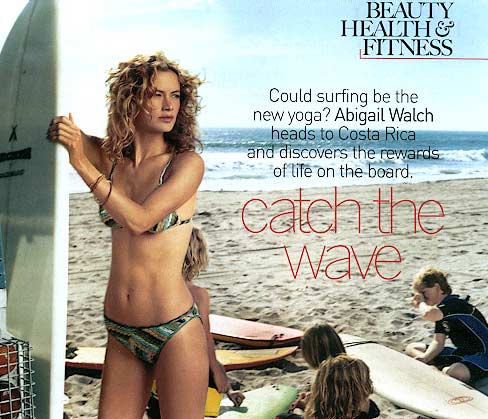VOGUE MAGAZINE, July 2005, page 99
Photo: Norman Jean RoyHANGING TEN Carolyn Murphy took time off from her modeling career to move to Costa Rica and surf.
For some, it's a slight jiggle under the arm. For others, a dimply pillow on the back of the thigh. For me, it's a gentle ro.11, one I could pinch or my cat would knead, right below my navel. Almost everyone has one, a stubborn body part that won't firm up no matter how low your weight drops or how hard you workout. I had all but given up on my soft spot until recently, when, for the first tune since high school, I gazed down and saw nothing. My Botticelli belly had disappeared, replaced by abs that were toned, hard, even a bit. ..cut. No nips, tucks, or marathon Abdomenizer sessions-I had been to surf camp, a seven-day retreat where the daily schedule is dictated by the tides.
It's not as if I thought, I want flat abs; I should surf. I kept hearing about women like me--young, landlocked professionals--who listed surfing as a hobby alongside yoga and dinner parties and knitting. They seemed cool in an I-can-do-anything sort of way. "Girls who know how to fix a flat tire, play the drums, or paddle out and rip--it gives them an edge," says Izzy Tihanyi, founder of Sun Diva, the world's first gir1s-only sun school, based in La Jolla, California. "You're stepping across the line into the boys' turf." Izzy counts Carolyn Murphy--"she really rips"-among the thousands of people she has taught to surf over the past nine years, and lists Minnie Driver, Juicy Coutre designer Pamela Skaist-Levy, and Urban Decay's cofounder Wende Zomnir as surf buddies. Surfing has come a long way since the iconic sixties film The Endless Summer; shedding its scruffy beach-boy image for a sophisticated allure. This spring, I decided I should--and would--learn to surf.
The difference between surfing against the backdrop of a ritzy resort versus a place stripped bare can be compared to eating a lobster roll at a five-star restaurant or biting into one at an oceanside clam shack. One feels pretentious, the other authentic, which is why I ended up at Vista Guapa, a coed sun camp in Jaco, Costa Rica. The whole work-for-thrills mantra of surfing spills over into the camp lifestyle: Vista Guapa's three bungalows have a stunning view of the Pacific Ocean, which you can enjoy after hiking up a short but steep hill. There are no TVs and no phones and certainly no hairdryers in the light and airy cabanas, but in-room massages soothe paddled-out shoulders.
As my first lesson drew near, I began to have serious doubts. Not only had I never surfed before, but I don't ski, snowboard, windsurf, or practice any other balance-required sport. Still, I was not a complete surfing naïf: A few weeks before heading to Costa Rica, I had enlisted the help of Paul Frediani, a Laird Hamilton-esque surfer who has trained the U.S. Surfing Federation team and recently created the new Equinox class Surf Flex. Paul had me practice pop-ups--springing from a push-up position to standing, as you do on a surfboard--and lift weights while kneeling on a stability ball to strengthen my upper body and core muscles, particularly my stomach. Whether paddling, standing, or sitting on the board waiting for the next wave, surfers are constantly engaging and toning-their abs, Paul explained. After a few sessions he delivered the fateful assessment: "You're flexible but not all that stable." (A more pithy and accurate diagnosis than any shrink has ever offered.) I thought about the push-ups Paul had suggested I do, but didn't, as I watched the other "campers" paddle out. That week's group included two women in their early 30s, financial types, who live in Los Angeles and own surfboards (but until camp, didn't know exactly what to do with them); a family of snowboarders from Wyoming; and a young woman from Hawaii who was deft enough to surf the early-morning session, when the instructors search the coast for the day's biggest waves.
As the complete rookie in the group, I was paired with local master Alvaro Solano, a six-time national surf champ who, along with his wife, Joice, founded Vista Guapa in 2002. Alvaro is not your stereotypical surfer who ends sentences with "dude" and lives off a diet of Mountain Dew and spliffs: He makes whole-wheat pancakes from scratch and rescues stray dogs. As Alvaro pensively looked over my soft, pale body, I couldn't tell if he was more worried that I'd be scorched by the blazing sun or trashed by the surf. He handed me sunblock (I'd already slathered my body with SPF 50, four times) and then walked me through the basics: how to pop up, where to position my feet, and how to resurface after wiping out (slowly and with your hands raised, so you don't whack your head into the board). We approached the boards. "Mine, it's like an F-l," he explained, pointing to his sleek five-foot-eleven, custom-made fiberglass board. "Yours? Yours is a truck." A nine-foot-six yellow semi made of Styrofoam, so big and buoyant I crossed sinking off my list of worries. I attached the board's leash to my ankle, and we headed out.
The first question everyone asks me when I tell them I went to surf camp is: Did you stand up? The truth is, getting up is relatively easy; paddling out is beyond tricky. It's not the distance (the waves were crashing pretty near the shore) so much as the entire time your upper body is in a frenzied race to outswim the crashing waves. Should you lose, you're knocked off the board and thrown into all underwater tug-of-war with your leash as the rope: On one side is the board yanking you toward the shore and the other your body searching for air. Once you resurface, the race is back on, starting with a mad scramble to hop back on the board before the next onslaught of water. The moment you manage to paddle over, under, and past the break conjures a euphoric elixir of utter satisfaction and quiet relief.
It didn't take me long to see that there's surfing and then there's surfing with training wheels, which is what I did. While I would lie belly-down on the board and paddle, Alvaro would push my board into a wave and scream, "Up," leaving me with one sole responsibility: to pop up and ride. On my first try, I did just that. I was so surprised by the concept of me on a surfboard, on a wave, that within seconds I half jumped, half fell off. But that fleeting moment was such a thrill, a sense of accomplishment, that I paddled right back out.
Over the next few sessions, I popped up with more confidence and even rode a few waves almost all the way to the shore, a mixed blessing. Yes, it's an exhilarating ride, but the grueling trek back through the impact zone, the breaking waves, is exhausting. When the waves were particularly relentless, the instructors--all male, all flirts, and all impeccably toned--would surf over, lend a hand, and offer a tow. It didn't take me long to let go of my pride and accept this act of surfing chivalry.
After just a week, my body felt stronger, firmer, more nimble. A friend told me that after she gave birth, she got back in shape--stomach and all--by surfing in Mexico for one month. I believe her. I indulged in delicious food (Vista Guapa serves pancakes almost the size of hubcaps), but I still managed to lose my winter weight. More important, surfing quieted my mind better than yoga or Xanax or a glass of Shiraz.
Back on dry New York City land, I recently swapped surf stories with Carolyn Murphy at a black-tie gala at the Waldorf. "People thought I was crazy to give up my life in New York, my modeling career, and move to Costa Rica to surf," she told me. "But I've never felt so stress-free, so pure, so good." I nodded in agreement: Surfing was one of the rare times when both my mind and body felt balanced. Now, when the demands of everyday life threaten to displace this newfound stability, a quick glance at my flat abs is a satisfying reminder of my core strength.



